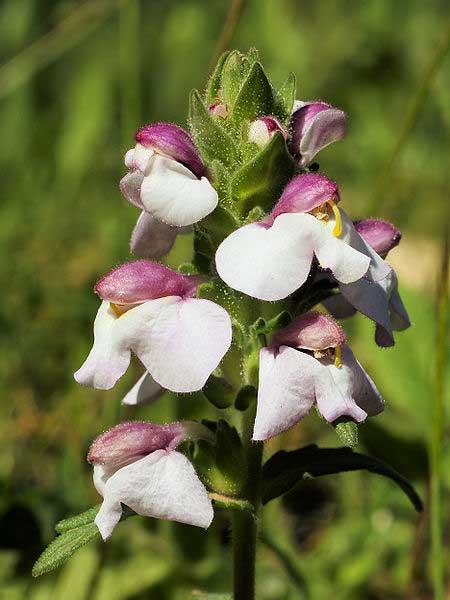
Bellardia trixago (*)
Classification System: APG IV
Superregnum: Eukaryota
Regnum: Plantae
Cladus: Angiosperms
Cladus: Eudicots
Cladus: Core eudicots
Cladus: Asterids
Cladus: Lamiids
Ordo: Lamiales
Familia: Orobanchaceae
Tribus: Rhinantheae
Genus: Bellardia
Species: Bellardia trixago
Name
Bellardia trixago (L.) All.
References
USDA, NRCS. 2006. The PLANTS Database, 6 March 2006 (http://plants.usda.gov). Data compiled from various sources by Mark W. Skinner. National Plant Data Center, Baton Rouge, LA 70874-4490 USA.
Allioni, Carlo, Flora Pedemontana sive Enumeratio Methodica Stirpium Indigenarum Pedemontii i. 61 (1785).
Vernacular names
English: Mediterranean Lineseed
Bellardia trixago is a species of flowering plant in the family Orobanchaceae (it has been formerly classified in the family Scrophulariaceae). The only member of the monotypic genus Bellardia, it is known as trixago bartsia[1] or Mediterranean lineseed.[2] This plant is native to the Mediterranean Basin, but it is known in other places with similar climates, such as California and parts of Chile, where it is an introduced species and noxious weed.
Etymology
The genus name Bellardia is a taxonomic patronym in honor of Carlo Antonio Lodovico Bellardi (1741-1826), an Italian botanist from Piedmont.[3]
The species name trixago has two possible etymologies.
It derives from the ancient Greek word θρίξ (thríx), meaning "hair",[4][5] and the Latin suffix ago used to indicate a property, and refers to the glandular-hairy characteristic of the plant.[6][7]
It derives from the ancient Greek word τριξός, τρισσός, or τριττός (trixós, trissós, or trittós), meaning "triple",[4][5] and refers to the trilobate lower lip of the flower.[8] It is also the old Latin name of germanders (genus Teucrium).[7]
Description
This is an erect plant often reaching over half a meter in height. Its foliage is rich green and dotted with glands and hairs. The sawtoothed leaves extend about halfway up the plant, with the upper half of the stem being occupied with a stout inflorescence which narrows to a point. The inflorescence has rows of leaflike bracts, between which emerge showy purple and white lipped, hooded flowers, each over two centimeters wide. The fruit is a smooth, green capsule. Mediterranean lineseed, like other broomrapes, is parasitic; this species is hemiparasitic in that it is green and photosynthetic but also taps into the roots of other plants to extract nutrients.
Phylogeny
The phylogeny of the genera of Rhinantheae has been explored using molecular characters.[9][10] Bellardia belongs to the core Rhinantheae. Bellardia is closely related to Parentucellia, to some Bartsia taxa, and to Odontites.[10][11] In turn, these genera share phylogenetic affinities with Tozzia and Hedbergia, and then with Euphrasia and Bartsia.
Genus-level cladogram of tribe Rhinantheae.
|
The cladogram has been reconstructed from nuclear and plastid DNA molecular characters (ITS, rps16 intron and trnK region).[9][10]
References
BSBI List 2007 (xls). Botanical Society of Britain and Ireland. Archived from the original (xls) on 2015-06-26. Retrieved 2014-10-17.
"Bellardia trixago". Natural Resources Conservation Service PLANTS Database. USDA. Retrieved 9 January 2016.
Rameau, Jean-Claude; Mansion, Dominique; Dumé, G. (2008). Flore forestière française: guide écologique illustré. Région méditerranéenne (in French). Forêt privée française. p. 1261. ISBN 978-2-904740-93-0.
Bailly, Anatole (1981-01-01). Abrégé du dictionnaire grec français. Paris: Hachette. ISBN 978-2010035289. OCLC 461974285.
Bailly, Anatole. "Greek-french dictionary online". www.tabularium.be. Retrieved May 2, 2020.
"Page T". www.calflora.net. Retrieved 2020-05-02.
"Bartsia". Plante Méditerranéenne (in French). Retrieved 2020-05-02.
Gentil, Ambroise (1923). Dictionnaire étymologique de la flore française (PDF). Paris: Paul Lechevalier. p. 229.
Těšitel, Jakub; Říha, Pavel; Svobodová, Šárka; Malinová, Tamara; Štech, Milan (2010-10-28). "Phylogeny, Life History Evolution and Biogeography of the Rhinanthoid Orobanchaceae". Folia Geobotanica. 45 (4): 347–367. doi:10.1007/s12224-010-9089-y. ISSN 1211-9520. S2CID 39873516.
Scheunert, Agnes; Fleischmann, Andreas; Olano-Marín, Catalina; Bräuchler, Christian; Heubl, Günther (2012-12-14). "Phylogeny of tribe Rhinantheae (Orobanchaceae) with a focus on biogeography, cytology and re-examination of generic concepts". Taxon. 61 (6): 1269–1285. doi:10.1002/tax.616008.
Uribe-Convers, Simon; Tank, David C. (2016-09-01). "Phylogenetic revision of the genus Bartsia (Orobanchaceae): disjunct distributions correlate to independent lineages". Systematic Botany. 41 (3): 672–684. doi:10.1600/036364416x692299. ISSN 0363-6445. S2CID 88752480.
Retrieved from "http://en.wikipedia.org/"
All text is available under the terms of the GNU Free Documentation License

